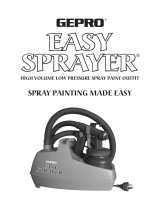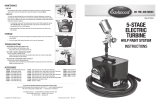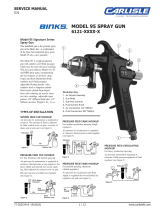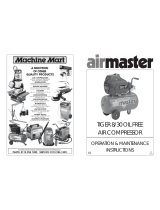Earlex SPRAYSTATION 6900 User manual
- Category
- Paint Sprayer
- Type
- User manual
This manual is also suitable for
Earlex SPRAYSTATION 6900 is a highly versatile low pressure paint system for a wide variety of applications. It enables the user to spray a wide range of paint with or without dilution, including water-based and solvent-based products. The system includes a powerful motor that provides a high volume of air (HV) and enables the product to be released from the fluid tip of the spray gun at a low pressure (0.18 bar). This results in a fine and even spray finish.
Earlex SPRAYSTATION 6900 is a highly versatile low pressure paint system for a wide variety of applications. It enables the user to spray a wide range of paint with or without dilution, including water-based and solvent-based products. The system includes a powerful motor that provides a high volume of air (HV) and enables the product to be released from the fluid tip of the spray gun at a low pressure (0.18 bar). This results in a fine and even spray finish.








-
 1
1
-
 2
2
-
 3
3
-
 4
4
-
 5
5
-
 6
6
-
 7
7
-
 8
8
Earlex SPRAYSTATION 6900 User manual
- Category
- Paint Sprayer
- Type
- User manual
- This manual is also suitable for
Earlex SPRAYSTATION 6900 is a highly versatile low pressure paint system for a wide variety of applications. It enables the user to spray a wide range of paint with or without dilution, including water-based and solvent-based products. The system includes a powerful motor that provides a high volume of air (HV) and enables the product to be released from the fluid tip of the spray gun at a low pressure (0.18 bar). This results in a fine and even spray finish.
Ask a question and I''ll find the answer in the document
Finding information in a document is now easier with AI
Related papers
-
Earlex 6900 Operating Instructions Manual
-
Earlex 0SS77USSG Installation guide
-
Earlex Spray Station 6900 User manual
-
Earlex HV5500US User manual
-
Earlex Spray Station 1900 User manual
-
Earlex L0553 User manual
-
Earlex Pro 8 Gun Owner's manual
-
Earlex SPRAY SYSTEM HV 1900 Operating Instructions Manual
-
Earlex SPRAYSTATION GEMINI User manual
-
Earlex SprayStation HV2901P User manual
Other documents
-
Campbell Hausfeld Paint Sprayer HV2100 User manual
-
 Gepro EASY SPRAYER User manual
Gepro EASY SPRAYER User manual
-
 Eastwood Apollo 1000ml Aluminum Cup - feed tube and Check Valve Operating instructions
Eastwood Apollo 1000ml Aluminum Cup - feed tube and Check Valve Operating instructions
-
Titan ProFinish Gun Owner's manual
-
Magnum pro Finex H5 HV3900VEUG Operating Instructions Manual
-
 Qtech QT830 User manual
Qtech QT830 User manual
-
Wagner SprayTech 3000, 3500 User manual
-
Harbor Freight Tools Paint Sprayer 92841 User manual
-
 Binks Model 95 Spray GunAIR CAP CHART User manual
Binks Model 95 Spray GunAIR CAP CHART User manual
-
 airmaster TIGER 8/30 Operation & Maintenance Instructions Manual
airmaster TIGER 8/30 Operation & Maintenance Instructions Manual












